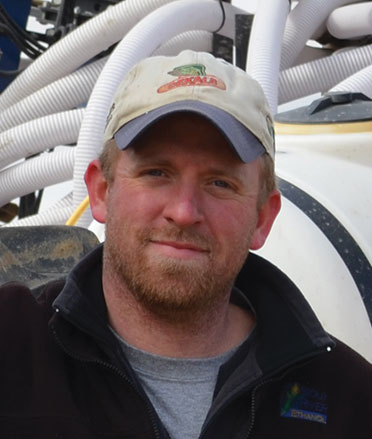Recently, Strip-Till Farmer editors caught up with four strip-tillers in a roundtable talk sponsored by AgroLiquid. The farmers chatted about everything from benefits they’ve seen from various nutrient management strategies, as well as challenges they’re facing and changes they’d like to make in the future.
Participants in this discussion included Ryan and Melissa Shaw of SKS Farm in Marlette, Mich.; Joey Hanson of Elk Point, S.D.; and Jeff Herrold of Wanatah, Ind. They brought their years of experience and insights with strip-tilling practices to the table for a candid and informative conversation.
Let’s start by having everyone share a bit of background information about your operation and your strip-till nutrient management system.
Joey Hanson: Here in the southeast corner of South Dakota, we started strip-tilling in 2013. Also in 2013, I launched Diversified Agronomy, a crop consulting business and a custom strip-till business.
This year we’re looking to try to get 8,000-9,000 acres covered this fall. We only use dry fertilizer right now, but we’ve debated setting up a liquid machine.
Melissa Shaw: We farm in the thumb of Michigan. We have 1,400 acres split into thirds — sugar beets, corn and soybeans. We’ve been strip-tilling since the fall of 2014 and it’s all dry fertilizer.
Jeff Herrold: I farm with my brother in northwest Indiana. We’re 75-80% under irrigation. We grow seed corn, field corn, soybeans, wheat and rye, and we’ve got an organic division. We started strip-tilling in 2012 or 2013, and we do the stripping in the spring, usually using dry fertilizer.
What nutrients do each of you put down when you’re building your berms?
Herrold: We’re not doing anything variable rate because we have one bin, so we’re putting on a mix of potash and MAP SZ (monoammonium phosphate with sulfur and zinc). We add some Wolf Trax in for micronutrients, and then some AMS (ammonium sulfate) or urea, depending on how much nitrogen (N) we want.

“I’m blessed with high phosphorus levels, but I have to get it into a form that’s available to me. Using zinc to do that helps a lot…” – Jeff Herrold
With our ground we have a lot of leaching, so I’m trying to be efficient with my fertilizer. Two years ago I dropped the rates quite substantially, but it felt like I was cutting myself short, so in spring 2020 we raised our rates to 200 pounds an acre.
We’re putting a lot of liquid on with the planter in a 2-by-2-inch configuration with a pop-up. That gets more nitrogen and phosphorous (P) into the plants, and then we come back with a sidedress. We’re staggering our N out in 3-4 different shots with the pivot. We switched to a Dawn from a knife setup 2 years ago. Our goal is to be the most efficient with our fertilizer as possible and use the least amount as we can.
Hanson: Rates are pretty specific field by field, but our primary focus is non-mobile nutrients — especially P and potassium (K). We put on no N in the fall except for what is in one of the primary products already — MAP or AMS. On the custom side, it’s very specific to the grower and to the field, but we do a lot of variable rate for the custom guys also. We’re probably at least 60-70% variable rate for our growers, with rates ranging from 0-600 pounds per acre.
The post-program to follow that up with is very common. We’ll all run about 50-60 pounds of N, typically with some ATS (ammonium thiosulfate) with our pre-burndown in the springtime. Then everybody sidedresses, including us, at least once. We try to do it 2 or 3 times, varying times throughout the year and of course depending upon soil types.
Ryan Shaw: Last year we didn’t apply any dry fertilizer. Because of the way the season was, we weren’t able to get out and make any strips. But the year before we averaged around 45-50 pounds of each variable rate across the farms. Some spots were calling for 200 pounds and others were calling for none.
We’ve been fortunate with some good soil tests, and we’ve been backing it down over the years. This spring, everything went through a pop-up in-furrow and then out the back behind the closing wheels on the surface for P and K, then all the N went out the back — about 70 pounds worth went on with the planter. Then we came back through and sidedressed the corn. We were shooting for 180-185 pounds — that’s usually our goal, depending on the productivity of each field.
How deep are you placing those?
Herrold: The knife we used to use went about 7 inches deep, but the Dawn goes about 5 inches deep. We spray the fertilizer on top and incorporate it in that whole zone.
Melissa Shaw: We plant in the same strips every year, so all our nutrients go in the same strip year after year. We apply it with our strips, probably 5-7 inches, and in the spring we just make a shallow seedbed to plant into.

“We try to incorporate some micronutrients into every application we do, whether it be from a strip-till application, a starter application or a post-liquid application…” – Joey Hanson
Hanson: Typically, we try to place our fertilizer toward the bottom of our strip (about 8 inches deep), especially in spring strip-till, but have started experimenting with blending throughout the profile to see if there is an advantage to having more of a consistent mixture of nutrients rather than a hot zone. Last fall though, we didn’t go as deep because we hadn’t had a substantial amount of moisture since the end of July. With the extremely dry, hard ground, it was not doing a very good job at 8 inches deep, so we went shallower. I’ve run some at 6 inches and I’ve run some at 7 inches. Typically, we try to place fertilizer toward the bottom of that — 6-7 inches is the target depth. We try not to get much shallower than that.
What micronutrients are you using, and when do you apply them? Are you seeing benefits from incorporating those into your overall nutrient plan?
Ryan Shaw: We’ve been focusing more on balance, and doing soil tests with micros. We do tissue sampling and know when we need to go in with the sugar beets and apply some magnesium or zinc. In the last couple years, we’ve zeroed in on different timings to perk them right back up.
Herrold: We use a lot of micronutrients. We’re really low on boron, zinc and sulfur. So I’m putting zinc in-furrow in a 2-by-2-inch configuration, and sidedress boron in a 2-by-2-inch configuration. We put about a gallon of boron on per acre, and the same with zinc. It’s extremely hard to keep the boron levels up in our tissue samples, so I can’t do it in just one shot. I’m blessed with high P levels, but I have to get it into a form that’s available to me. Using zinc to do that helps a lot.
Hanson: It’s a little challenging with a two-tank system to try to variable-rate apply any micros. Our potash application typically has the least amount of variability, and that’s where we’ll incorporate some of our micros — primarily zinc. We’ve used the Wolf Trax micronutrient package product quite a bit, too.
We try to focus in on some zinc, some sulfur and some boron. We do tissue samples throughout the season. But we focus on more boron application later on in the season — that’s where some of the biggest bang for our buck is. We try to incorporate some micronutrients into every application we do, whether it be from a strip-till application, a starter application or a post-liquid application.
What kinds of soil conditions are you strip-tilling into?
Herrold: We are mainly a sandy loam, and our pHs are usually low. When my grandpa farmed it, they just poured on the dolomitic lime. We’ve spent the last 20 years trying to reverse that with high calcite lime, and we’ve actually changed the curve. Now we’re going back to dolomitic, because our magnesium levels are getting too low. Now it’s field by field, as to whether we’re going high calcite or dolomitic lime.
Ryan Shaw: Most of our stuff is right about balanced for pH, or a little bit high.
Hanson: We strip anything from sand to heavy gumbo clay. We fight high magnesium. It’s interesting listening to Jeff talk about magnesium issues — we typically have the opposite issue and fight high magnesium levels and tight, sticky soils. Drainage is a major issue for us.
We’re tabletop flat, with a lot of loam and clay soils. It’s common to see ranges of 5-8 pH, sometimes in the same field. So we fight that, which is why you see so much variable rate being used in our neck of the woods.
What would you say is the biggest challenge with your fertility program as it stands right now?
Hanson: I wish there was a better option to individually vary just one or two micronutrients. That’s one thing I’d like to see addressed — to be able to specifically apply smaller rates of some of those micros, rather than tank-mixing them.

“We plant in the same strips every year, so all our nutrients go in the same strip year after year…” – Melissa Shaw
Herrold: Some products aren’t delivering what they say they are, and the proof is in the tissue sample. We spray boron, and 2 weeks later we go out and test it, and we have no boron. I feel like I just wasted my money.
Everyone wants to sell their product as having the most available boron or zinc or magnesium, and it would be really nice to have data behind that. The last thing I want to do is spend a bunch of money on something that’s not working.
Ryan Shaw: One of our biggest struggles was with the soil testing we did in the last 2 years — when we got it back, we needed to know how we could apply it right away. We had quite a few fields that needed some magnesium, but we had already planted some of the fields and we didn’t want to run a floater over it. We got some Epsom salt and broadcasted it over the top with our interseeder.
We’ve been trying to send tissue samples of our sugar beets in each week to build a timeline, because we can’t get a good handle on when the beets are looking for which nutrients. It’s been more of a struggle to analyze that than it was for corn and beans. We want to chase that down a little bit more, but it’s going to take a few years.
Looking ahead, what do you see as one update you’d like to make in the next few years to improve your strip-till system?
Ryan Shaw: We’ve been trying to get a cover crop established and keep it there. We’d like to find somebody with a band sprayer, or possibly put some liquid on our strip-till machine and put a pre-emergent herbicide down and only have a pre in our strips. That way we could burn everything off before everything comes up. We wouldn’t have to worry about our residual hangover, and it would get us better timing.
Hanson: In 2019, we did some cover crops for the first time, mostly because of prevent plant. We raised some of the best crops we’ve ever raised, despite having a drier second half of the summer. We’d like to try to tie in some cover crop seeding with the strip-till machine, potentially between the rows. We’d also like to get a liquid application set up on our dry machine for some flexibility.
Herrold: I’m toying around with going back to a knife setup. We went from a Gladiator to a Dawn, and we’re not getting the compaction taken out with the Dawn. It has me wondering if I should go back to a knife to get deeper. Right now I’m basically in-line ripping in the fall, then a strip in the spring to take that deep compaction out. That’s not something I want to be doing, but it’s definitely necessary.





